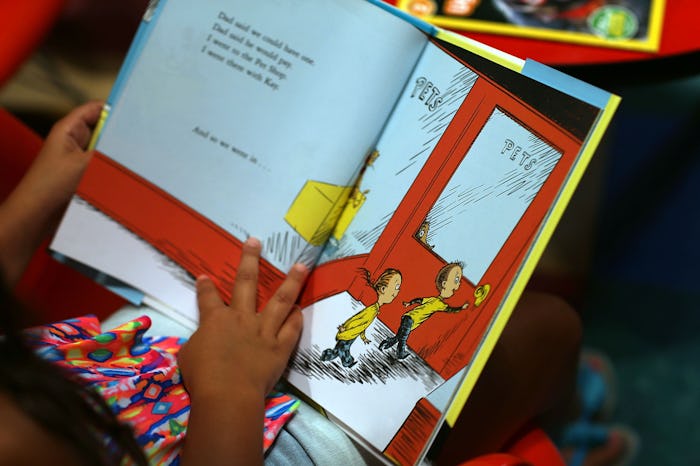Life

Here's Why Your Kid Is *So* In Love With Dr. Seuss Books
Why do kids love reading Dr. Seuss books so much? Oh, let me count the ways. 1 fish, 2 fish... Yes indeed, there are many wacky reasons why children love Dr. Seuss, and in turn, so many ways that reading Dr. Seuss books are great for kids. As The Cat in The Hat would say, "From there to here, from here to there, funny things are everywhere!" Let's dive in like a red fish, shall we?
Theodor Seuss Geisel, otherwise known as Dr. Seuss, became an overnight success with The Cat in The Hat, which was written in response to a LIFE magazine article in 1954 that criticized children's reading levels. According to Biography, publishers asked him to create a children's primer containing 220 vocabulary words, and the rest, shall we say, is history.
"The more that you read, the more things you will know. The more that you learn, the more places you’ll go." ― Dr. Seuss, I Can Read With My Eyes Shut
Children love the nonsensical, silly made-up names, creatures, stories, and rhyming structure within Dr. Seuss' books, and as it turns out, those rhymes are beneficial for children, too. According to Learning Lift Off, rhyming helps develop literacy, promotes language, and encourages social and emotional development. Rhymes sound even better when they are read aloud, too. Many Dr. Seuss books are available in book board format, making them the perfect size for tiny hands. And as stated by the American Academy of Pediatrics, reading to children from infancy promotes brain development, not to mention a lifelong love of reading.
In all of Dr. Seuss' books, you'll find repeating sounds and stories that engage. A child learning how to read can benefit from phonics, says The Children's Book Review, which is a teaching method that correlates sounds with letters or groups of letters. Dr. Seuss was a master at creating this structure using limited vocabulary, which is also appealing for young readers.
For all the zany characters and tongue twisters, Dr. Seuss stories are also filled with positive messages and life lessons. Even the grouchy Grinch of How The Grinch Stole Christmas is no match for little Cindy Lou Who of Whoville. The triumph of good versus evil is universal, and children love to see the bad guy lose (or in the case of The Grinch, a massive change of heart). Perhaps this has to do with their innate moral compass from birth, according to The Baby Lab at Yale University.
The best example of Dr. Seuss' own moral compass is, of course, The Lorax. If only Dr. Seuss could have known how relevant this story would become as it centers around the environment and the notion of standing up for those that cannot stand up for themselves. When the Lorax "speaks for the trees," he speaks for everyone. We all root for the Truffula trees to come back, and at the end of the story, the reader is left feeling optimistic.
"Plant a new Truffula. Treat it with care. Give it clean water. And feed it fresh air. Grow a forest. Protect it from axes that hack. Then the Lorax and all of his friends may come back." ― Dr. Seuss, The Lorax
Perhaps we should end with a smile, as long as a mile (pardon my Dr. Seuss impression). Fans young and old will be excited to learn that an unfinished manuscript for one last Dr. Seuss book was discovered upon the author's passing. With the help of Australian author and illustrator Andrew Joyner, Dr. Seuss's Horse Museum will be released this fall by Random House. Be on the lookout!